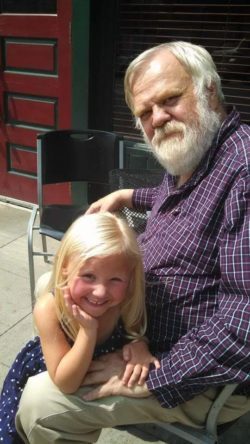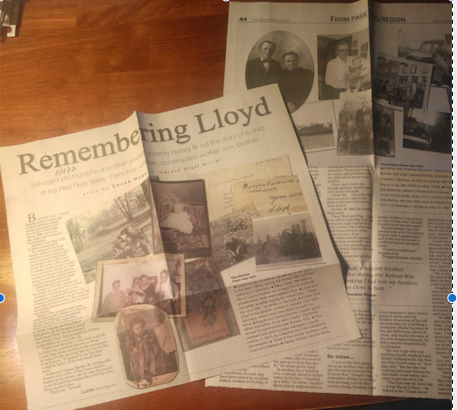
EDITOR'S NOTE: Metrics aside, the true test of a good story is that it evokes other stories. That's what happened when I asked veteran storyteller Chuck Haga to write a "Why's This So Good" essay about a story by James Eli Shiffer, an editor at the Star Tribune in Minneapolis. Shiffer's piece, based on a trove of old photos, wove threads of research and emotion to create a tapestry of the too-short life of a lovely, and much-loved, little girl. Haga said Shiffer's story reminded him of a piece he had done five years earlier, for the Grand Forks Herald, based on a three-paragraph obituary and a similar trove of photographs that came his way.
Haga has long been someone I follow to study how to blend honest reporting with honest emotion. He had a storied career at the Grand Forks Herald and Star Tribune, and now teaches and mentors lucky students at the University of North Dakota.
In honor of our belief that stories beget stories, we are reprinting Haga's story below, with permission. Pair his piece side-by-side with Shiffer's provides a great lesson in the power of curiosity, the quest for answers and the truth that compelling stories are wherever you look.
REMEMBERING LLOYD
Salvaged photographs and other pieces of family history fill out the story of a child of the Red River Valley: Farm boy, veteran, construction worker, son, brother.
By Chuck Haga
Grand Forks Herald
November 11, 2012
BUXTON, N.D. - Lloyd Domier died 17 years ago. A brief obituary notice in the newspaper said he was born near Buxton in 1928, served in the Army and worked in construction.
And that was that: a life in three paragraphs.
He was part of a large family, with six brothers and four sisters. But Lloyd never married, the family has largely died off or scattered, and only a few older residents of this Traill County town recall the Domiers. Like members of previous generations, Lloyd was quietly fading into the unremembered past.
Then the pictures came.
A man in Florida, taking out his trash one day this fall, spotted a bundle of photographs in his apartment complex Dumpster. Curious, he fished them out. In faded images and scrawled notes, they hinted at a multigenerational story, the story of a family.
Many of the pictures had notations that made reference to the little town of Buxton in northeast North Dakota. The man who found the photos had been born in North Dakota, and his father had grown up in Prosper, a small town near Fargo. So, he shipped the photos, more than a hundred of them, to his father in Louisville, Ky.
"I have had them for a while but really do not have any personal interest in them," Loren Waa wrote recently to the newspaper in Grand Forks, knowing the city was not far from Buxton. "It seemed to me that they would be better off in your hands than mine."
In Buxton, Duane Bjerke, 84, visiting with friends over coffee at the Cenex station, looked at the photos, one by one. He paused as he studied the smiling face of a boy, a boy from another time.
"That's me," he said.
"I was raised on a farm 4½ miles west of here," Bjerke said. "The Domiers were on a farm 3½ miles west. Lloyd ran with the same crowd I did, but he kept mostly to himself. He worked for a construction outfit for many years. They built elevators. Pretty much the whole family worked for that company."
Bjerke smiled as he remembered one of Lloyd's brothers.
"I was a police officer here for 10 years," he said. "Lloyd's brother, Douglas, was a little wild, and I had to talk to him a few times.
"He became a minister. He was back here once and he thanked me. He credited me with steering him in the right direction."
Another man in for coffee called for Doug Thompson, the Cenex manager. "Don't you have an address for Douglas Domier out in California?"
The family still had a financial interest in the cooperative, and Thompson quickly found an address.
"I have a phone number, too," he said, "but I don't know how current that is."
Remembering
"Of the brothers, he (Lloyd) was the closest to me," the Rev. Douglas Domier said last week from San Juan Capistrano, Calif., where he lives.
"He was an older brother who really encouraged me to continue with my schooling," Douglas said. "He invested in me, personally and financially and every other way, to encourage me to finish school and go to college."
The photos, he said, may have been tossed by an ailing elderly relative in Florida, or by someone caring for her.
"Yes, I would very much like to have them," he said.
The photos include old-time images of a chubby-cheeked boy and a baby girl: Douglas and Lloyd's father and mother. Their maternal grandparents are dressed in their Sunday best for a formal portrait, and their paternal grandfather poses as a young man with five brothers.
A reprint of a studio portrait taken about 1900 shows a proud elderly couple, also dressed for the moment: Lloyd's paternal great-grandparents, Henrik and Kari Domier. With the photo is a copy of the passenger list from the Norway-Heritage Line's Fauma, the three-masted sailing ship that brought them to America in 1867.
Newer images show a young Lloyd at work on a farm, posing with two brothers, and sitting on the fender of a 1940s-era car with a toddler, a nephew perhaps, in his lap. Snapshots barely an inch square, taken in the early 1950s, show a young man in uniform, sitting with a girl on a park bench, and standing jauntily outside a café in Frankfurt, Germany. "A German café that most of the guys go to from this outfit," he wrote on the back.
In another, he is bending over a stream, about to splash water on his face. "Cleaning up a little," he wrote. Another shows him in uniform and reclining on a bed, maybe in a barracks. "This is my room," he wrote, and probably sent the little photo home to his mother.
There are letters, too, though spelling clearly was not Lloyd's strength.
"Dear Ma Just a line to tell you not to right to me here I will leave here party soon. Lloyd."
On Jan. 29, 1952, he wrote a little more.
"Dear Mom and Pop I got your letter yesterday but I sat down last night and tried to write a letter but I could not think of anything to write about so I gave it up."
He wrote that it was good to hear they were well "and that the roads are still open" back in North Dakota. He was a farmer's son.
He told about the weather there in Germany, too, how there was snow on the ground but it was melting and would probably be gone by the end of the day.
"Well, that is about all I have to write about now. Tell all the kids hello from me and grandma too, and tell Douglas I will write him a letter real soon."
So close
"I was in the first grade when my brother was called into the service during the Korean War," Douglas said. "I remember sitting on a swing that morning outside the school, crying, thinking I had lost my brother. I was already so close to him, and I thought I would never see him again."
People thought Lloyd resembled the actor Humphrey Bogart, both in appearance and in the way he moved, a confident but not arrogant stride.
"I loved to watch him," Douglas said.
Though he never married, Lloyd appears to have been a popular uncle and big brother. In several of the old photographs, he is holding a youngster. Maybe because of the age difference, about 15 years, and maybe because of his own disappointments, he felt a special responsibility for Douglas.
"He was a guy who was pushing ahead, working hard, always looking to the day that his ship would come in," Douglas said. "But he also was looking back and wishing he had made some better decisions to get ahead in life.
"The first time he hired me — I was about 15 then — he talked to me: 'I have never backed up to anyone in my life to pick up a paycheck. I've always taken my paycheck and looked in their eyes.' And he wanted me to do the same."
Lloyd was a construction foreman with a crew, building grain elevators. "We worked like animals, 14 to 16 hours a day, and he always tried to finish a job before other crews," Douglas said. "We were paid by the hour, but it was a thing of honor to him.
"We were a very poor family, kind of the lower class out there by Buxton. That bothered Lloyd a lot."
Douglas said he didn't always hold to the straight and narrow as a teenager. "I had started alcohol, chasing around," he said. But Lloyd persuaded him to study hard at school, work hard at his job and plan for college.
"In 1960, I was a few weeks into my first year at Mayville State. Lloyd came home from work with a 1958 Ford Fairlane. ‘I want you to have a good car to drive to and from school,' he said. He also took me down to the bank and started an account so I'd have money for gas and things.
"And he said, 'But I tell you, you little S-O-B, if you spend my money on booze and women, I'll …' Well, it worked."
Douglas graduated from Mayville (N.D.) State University and went on to earn advanced degrees. He entered a seminary, was ordained and spent 20 years as a missionary in Guatemala, Ecuador and Costa Rica. At 70, he continues to work with Spanish-speaking ministries in the southwest United States.
"If he had not encouraged me to continue my studies, pushed me to hold onto my values and try for a better life, I probably would have continued on in the beer-drinking construction industry.
"I became his hero. But I did it basically for him. I am greatly indebted to my brother."
Another photo
In his mid-40s, Lloyd was working at a construction site one day when he fell 25 feet to a concrete surface, Douglas said. The fall damaged his spinal column, and he was in pain most of the rest of his life.
In the packet of photographs that help to explain who he was, where he came from and who he became, there is a picture of Lloyd lying in a hospital bed, probably just after the accident.
He died on May 8, 1995, in Union Hospital in Mayville, at the age of 66.
He was buried in Immanuel Cemetery, rural Buxton.
He is remembered.



